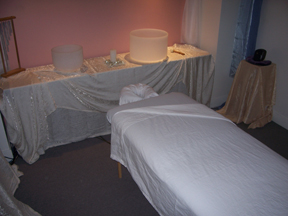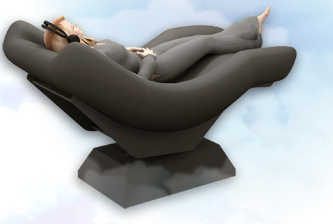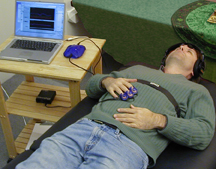
Sound Tables and Vibroacoustic Treatments
A Sound Table is a massage table with powerful low frequency speakers mounted on the bottom of the table. The table itself acts like a speaker sending healing low frequency vibrations throughout every cell of your body. Sound tables are used in vibroacoustic therapies, which are treatment methods based on the combined effects of music and low frequency sound vibration. Auditory and vibratory stimulations are applied to the body to achieve physical and psychological results. Since the 1980’s, the use of vibroacoustic equipment has spread across the globe. It is used in a wide range of settings, including hospitals, hospices, spas, and centers for massage therapy, sound therapy, alternative health, yoga, physical therapy, and psychiatric treatment, and by individual therapists.
The Smart Lounge
Latest technologies and custom design materials are the foundation upon which the Smart Lounge was created. This ergonomic motion relaxer uniquely incorporates balanced body positioning and soothing wave simulation to promote relaxation within minutes of reclining. Therapeutic stress-relieving foam lies just beneath custom-selected upholstery and conforms to the body’s unique contours. The stress-free posture helps alleviate muscle tension, realign vertebrae, enhance breathing, improve circulation and stimulates the vestibular system.
With the lounge generating a soothing three-dimensional motion, a digital signal processor and low frequency transducers work together to deliver non-invasive massage techniques that calm the mind and soothe the body.

Vibroacoustics Research and Techniques on Sound Tables
Clinical Research in Hospitals and Institutions
Ongoing since 1995, the National Institutes of Health runs the most extensive program in the U.S. for vibroacoustic pain and symptom reduction, treating over 50,000 patients per year. In measuring the physiological and behavioral effectiveness of these interventions with 267 patients, Dr. Patrick George found over a 50% reduction of pain and symptoms. He theorizes that this pain relief is relaxation-induced.
Tests with chemotherapy patients at the Jupiter Medical Center in Florida found similar results: 62.8% reduction of anxiety and 61.6% reduction of fatigue for 27 patients in 41 vibroacoustics sessions. A study at Duke University Medical Center also reported significant pain reduction for 20 women who had surgery for various cancers. Also at Duke, vibroacoustics was tested in physical therapy following total knee replacements, showing increased range of motion. Heart surgeons using vibroacoustics therapy during cardiac surgery recovery found significant decreases in patients’ use of sedative and pain medication, time spent on the ventilator, time spent in the cardiac unit, and overall time spent in the hospital.
These are but a few of the many studies on vibroacoustics. Many point to the effectiveness of the therapy in triggering the Relaxation Response. Physiologically, the relaxation response initiates the following changes:
• Reduces oxygen consumption 
• Decreases blood pressure
• Slows heart rate
• Slows respiration rate
• Relaxes muscles
Mentally, deep relaxation:
• Changes brain wave frequencies (generally slowing down from beta to alpha and alpha to theta or delta)
• Clears the mind from anxiety
• Creates a feeling of calm and peacefulness
As an additional benefit, vibroacoustics can help people to learn to recognize the state of relaxation and, over time, become able to reach relaxation at will. Vibroacoustics is a great way to learn how to relax and develop relaxation as a daily habit!

